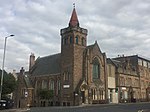Royal Public Dispensary of Edinburgh
1776 establishments in Scotland1776 in science1963 disestablishments in Scotland1963 in scienceCharities based in Edinburgh ... and 10 more
Defunct hospitals in ScotlandDispensaries in the United KingdomHistory of medicine in the United KingdomHistory of science and technology in ScotlandHistory of the University of EdinburghHospitals in EdinburghScottish building and structure stubsScottish history stubsScottish organisation stubsUse British English from August 2017

The Public Dispensary of Edinburgh was the first free-of-charge hospital in Scotland.
Excerpt from the Wikipedia article Royal Public Dispensary of Edinburgh (License: CC BY-SA 3.0, Authors, Images).Royal Public Dispensary of Edinburgh
West Richmond Street, City of Edinburgh Southside
Geographical coordinates (GPS) Address Website Nearby Places Show on map
Geographical coordinates (GPS)
| Latitude | Longitude |
|---|---|
| N 55.9456 ° | E -3.1836 ° |
Address
Mackenzie Medical Centre
West Richmond Street 20
EH8 9DX City of Edinburgh, Southside
Scotland, United Kingdom
Open on Google Maps









